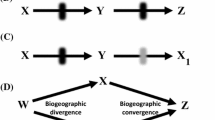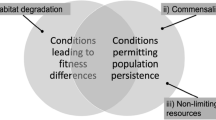Abstract
In 2017 we published a paper in this journal proposing a philosophical framework for recognizing ecological communities as natural entities, the Evolutionary Community Concept (ECC). That paper attracted a lengthy reply; herein we take the opportunity to clarify critical aspects of the ECC and use a case study (the longleaf pine forest) to demonstrate how the ECC can be made operational. We maintain the ECC provides a framework useful for establishing objectives associated with ongoing and proposed restoration and conservation efforts.
Similar content being viewed by others
References
Barker FK, Burns KJ, Klicka J, Lanyon SM, Lovette IJ (2015) New insights into New World biogeography: an integrated view from the phylogeny of blackbirds, cardinals, sparrows, tanagers, warblers, and allies. Auk 132:333–348
Block WM, Conner LM, Brewer PA, Ford P, Haufler J, Litt A, Masters RE, Mitchell LR, Park J (2016) Effects of prescribed fire on wildlife and wildlife habitat in selected ecosystems of North America. The Wildlife Society Technical Review 16-01. The Wildlife Society, Bethesda, Maryland, USA
Bonnicksen TM (2000) America’s Ancient forest: from the ice age to the age of discovery. Wiley, New York
Bourgeon L, Burke A, Higham T (2017) Earliest human presence in North America dated to the last glacial maximum: new radiocarbon dates from bluefish caves. Canada PLoS ONE 12(1):e0169486. https://doi.org/10.1371/journal.pone.0169486
Carroll WC, Kapeluck PR, Harper RA, Van Lear DH (2002) Background paper: historical overview of the southern forest landscape and associated resources. In: Wear DN, Greis JG (eds) Southern forest resource assessment. USDA Forest Service GTR SRS-53, Asheville, pp 583–606
Cassey P, Blackburn TM, Duncan RP, Chown SL (2005) Concerning invasive species: reply to Brown and Sax. Austral Ecol 30:475–480
Cerros-Tlatilpa R, Columbus JT, Barker NP (2011) Phylogenetic relationships of Aristida and relatives (Poaceae: Aristidoideae) based on noncoding chloroplast (trnL-F, rpl16) and nuclear DNA sequences. Am J Bot 98:1868–1886
Colwell R (2008) RangeModel: tools for exploring and assessing geometric constraints on species richness (the mid-domain effect) along transects. Ecography. https://doi.org/10.1111/j.2008.0906-7590.05347.x
Darwin C (1859) On the origin of species by means of natural selection, or preservation of favoured races in the struggle for life. John Murray, London
Delacourt PA, Delacourt HR (1987) Long-term forest dynamics in the temperate zone. Ecological Studies 63. Springer, New York
Donlan JC, Berger J, Bock CE, Bock JH, Burney DA, Estes JA, Foreman D, Martin PS, Roemer GW, Smith FA, Soulé ME (2006) Pleistocene rewilding: an optimistic agenda for twenty-first century conservation. Am Nat 168:660–681
Fowler C, Konopik E (2007) The history of fire in the southern United States. Human Ecol Rev 14:165–176
Guyette RP, Stambaugh MD, Dey DC, Muzika R-M (2012) Predicting fire frequency with chemistry and climate. Ecosystems 13:322–335
Herrera-Alsina L, Villegas-Patraca R (2014) Biologic interactions determining geographic range size: a one species response to phylogenetic community structure. Ecol Evol 4:968–976
Hernández-León S, Gernandt DS, Pérez de la Rosa JA, Jardón-Barbolla L (2013) Phylogenetic relationships and species delimitation in Pinus Section Trifoliae inferred from plastid DNA. PLoS ONE 8(7):e70501. https://doi.org/10.1371/journal.pone.0070501
Hipp AL et al (2019) Genomic landscape of the global oak phylogeny. New Phytol. https://doi.org/10.1111/nph.16162
Huffman JM (2006) Historical fire regimes in southeastern pine savannas. Dissertation; Louisiana State University
Jachowski DS, Kesler DC (2009) Allowing extinction: should we let species go? Proc Natl Acad Sci 105:2919–2922
Komarek EV (1968) Lightning and lightning fires as ecological forces. In: Proceedings of the 8th Annual Tall Timbers Fire Ecology Conference, pp 167–197
Krysko KL, Nuñez LP, Lippi CA, Smith DJ, Granatosky MC (2016) Pliocene-Pleistocene lineage diversifications in the Eastern Indigo Snake (Drymarchon couperi) in the Southeastern United States. Mol Phylogenet Evol 98(2016):111–122
Lawing AM, Polly PS (2011) Pleistocene climate, phylogeny, and climate envelope models: an integrative approach to better understand species’ response to climate change. PLoS ONE 6(12):e28554. https://doi.org/10.1371/journal.pone.0028554
Oaks JR (2019) Full Bayesian phylogeography from genomic data. Syst Biol 68:371–395
Platt WJ, Evans GW, Rathbun SL (1988) The population dynamics of a long-lived conifer (Pinus palustris). Am Nat 131:491–525
Pyne SJ, Andrews PL, Laven RD (1996) Introduction to wildland fire, 2nd edn. Wiley, New York
Rostal DC, McCoy ED, Mushinsky HR (2014) Biology and conservation of North American tortoises. John Hopkins University Press, Baltimore
Sagoff M (2019) When is it co-evolution? A reply to Steen and co-authors. Biol Philos 34:10
Savage JM (1982) The enigma of the Central American herpetogauna: dispersals or vicariance? Ann Mo Bot Gard 69:464–547
Steen DA, Barrett K, Clarke E, Guyer C (2017) Conceptualizing communities as natural entities: a philosophical argument with basic and applied implications. Biol Philos 32:1019–1034
Taylor AR (1974) Ecological aspects of lightning in forests. Annual tall timbers fire ecology conference number 13. Tall Timbers Research Station, Tallahassee, pp 455–482
Van Lear DH, Carroll WD, Kapeluck PR, Johnson R (2005) History and restoration of the longleaf pinegrassland ecosystem: implications for species at risk. For Ecol Manag 211(1–2):150–165
White PS, Walker JL (1997) Approximating nature’s variation: selecting and using reference information in restoration ecology. Restor Ecol 5:338–349
Yuan Z-Y et al (2016) Spatiotemporal Diversification Of The True Frogs (Genus Rana): a historical framework for a widely studied group of model organisms . Syst Biol 65(5):824–842
Zhang Y, Majumdar I, Schelhas J (2010) Changes in woodland use from longleaf pine to loblolly pine. Sustainability 2:2734–2745
Acknowledgements
E. Clarke, S. Hermann and J. Kush provided critical reviews of earlier versions of this manuscript. This work is dedicated to the memory of our colleague and teacher, Dr. Nanette Chadwick.
Author information
Authors and Affiliations
Contributions
Authors contributed equally from conception to writing and editing.
Corresponding author
Ethics declarations
Conflict of interest
The authors declare that they have no conflict of interest.
Additional information
Publisher's Note
Springer Nature remains neutral with regard to jurisdictional claims in published maps and institutional affiliations.
Rights and permissions
About this article
Cite this article
Barrett, K., Guyer, C. & Steen, D.A. The evolutionary community concept is fully armed and operational: a reply to Sagoff. Biol Philos 35, 57 (2020). https://doi.org/10.1007/s10539-020-09775-x
Received:
Accepted:
Published:
DOI: https://doi.org/10.1007/s10539-020-09775-x




